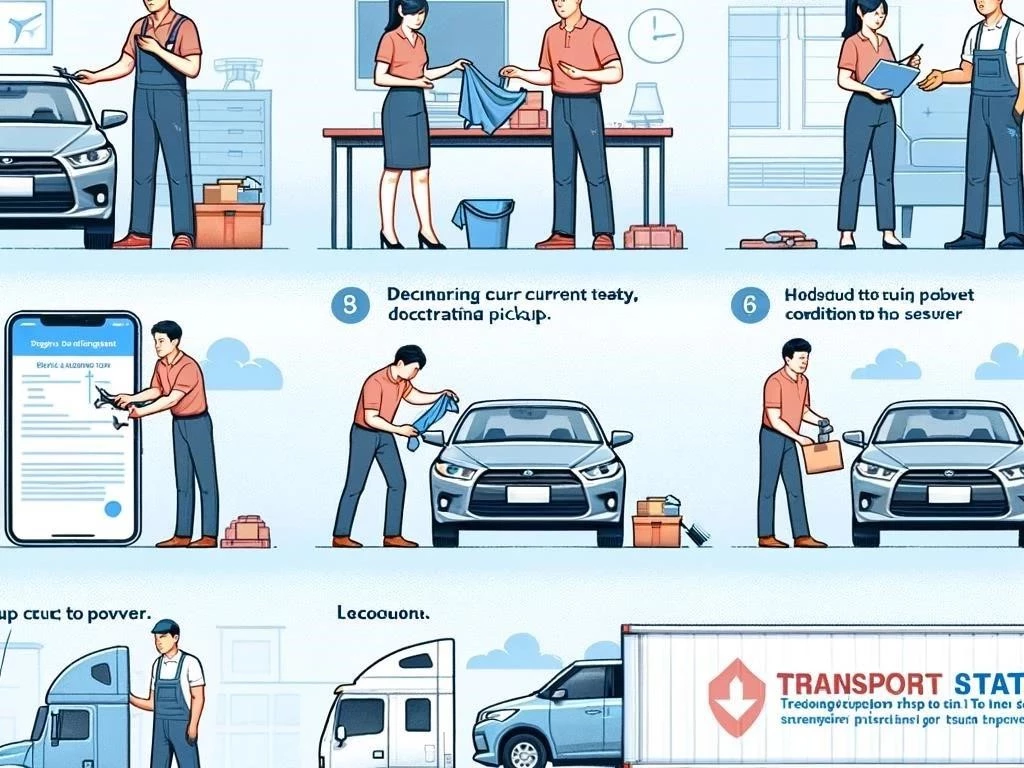How Do You Ship a Car to Another State?
Shipping a car involves selecting reputable auto transport services, understanding logistics, and ensuring compliance with interstate car shipping regulations for efficient vehicle relocation.
Understanding Car Shipping
Car shipping refers to the process of transporting vehicles from one location to another, often across state lines. This service is essential for individuals relocating, purchasing vehicles online, or sending cars to loved ones. Auto shipping services can vary widely, with different methods available for transport, including open and enclosed transport options. Understanding the various aspects of vehicle relocation helps in making informed decisions. Factors such as shipping costs, timelines, and the safety of your vehicle during transit are crucial. It’s also important to be aware of car shipping regulations that apply in different states to ensure a smooth shipping experience without legal complications.
Choosing Auto Transport Services
When selecting auto transport services, consider factors like reputation, customer reviews, and the types of services offered. Look for vehicle shipping companies that provide transparent car shipping quotes and detailed information about their transport options. Research both enclosed and open transport methods to determine which suits your needs best. Ensure the company has the necessary insurance and licensing to handle interstate car shipping. It’s also beneficial to inquire about their experience with long-distance car shipping, as this can impact the safety and timeliness of your vehicle’s delivery. Communication and customer support are essential for a smooth car transport logistics process.
Types of Vehicle Relocation Methods
There are several vehicle relocation methods to consider when shipping a car. The two primary options are open transport and enclosed car transport. Open transport is the most common and cost-effective method, where vehicles are loaded onto a trailer without any covering, exposing them to weather and road conditions. Conversely, enclosed car transport offers enhanced protection, as vehicles are transported in a fully enclosed trailer, safeguarding them from elements and potential damage. While enclosed transport typically incurs higher shipping costs, it is ideal for luxury or classic cars. Understanding these options is crucial for choosing the best method for your specific needs and budget.
3.1 Open Transport
Open transport is a popular and economical method for shipping a vehicle across state lines. In this method, vehicles are loaded onto an open trailer, which can carry multiple cars simultaneously. This approach typically results in lower shipping costs compared to enclosed transport. However, vehicles transported via open transport are exposed to the elements, including weather conditions, road debris, and potential scratches. It’s suitable for standard cars, as well as those that are not particularly valuable. When using open transport, ensure that the auto shipping company has good insurance coverage for added peace of mind during the vehicle relocation process.
3.2 Enclosed Car Transport
Enclosed car transport is an ideal option for those seeking maximum protection for their vehicles during shipping. This method utilizes a fully enclosed trailer, safeguarding cars from harsh weather, road debris, and potential damage. Enclosed transport is particularly beneficial for luxury, classic, or high-value vehicles, as it provides peace of mind during long-distance car shipping. While this method generally incurs higher shipping costs than open transport, the added security and protection can be well worth the investment. When selecting enclosed car transport, ensure the chosen auto shipping company specializes in this service and offers adequate insurance coverage for your vehicle throughout the relocation process.
Getting Car Shipping Quotes
Obtaining car shipping quotes is a crucial step when planning to ship a vehicle across state lines. Start by reaching out to multiple vehicle shipping companies to compare rates and services. Most companies provide online car shipping quotes, allowing for easy access to pricing information. Be prepared to provide essential details, such as the vehicle’s make and model, pickup and delivery locations, and preferred shipping method. Additionally, inquire about any hidden fees that may affect the overall shipping costs. Analyzing multiple quotes helps ensure you receive the best value for your money while meeting your specific vehicle transport needs and preferences.
Preparing Your Vehicle for Shipping
Preparing your vehicle for shipping is essential to ensure a smooth transport process. Start by cleaning the exterior and interior of the car, as this allows for a thorough inspection and helps document any existing damages. Next, check fluid levels, tire pressure, and battery condition to ensure the vehicle is in good working order. Remove personal belongings, as they are not covered by insurance during shipping. Document the vehicle condition with photographs, capturing any scratches or dents. Finally, make sure to disable any alarm systems to prevent unnecessary disturbances during transport. Proper preparation will contribute to a hassle-free vehicle relocation experience.
5.1 Cleaning and Inspecting the Vehicle
Cleaning and inspecting your vehicle thoroughly before shipping is crucial for a successful transport experience. Begin by washing the exterior to remove dirt, grime, and any debris, which will help reveal any existing scratches or dents. After cleaning, conduct a careful inspection of the vehicle, checking for any damage that might require documentation. Take detailed photographs of the car from various angles, including close-ups of any imperfections. This documentation serves as a record in case of disputes regarding damages during transport. Additionally, ensure that all compartments are empty and clear of personal items to avoid complications during the shipping process.
5.2 Documenting the Vehicle Condition
Documenting the vehicle condition is a vital step before shipping your car across state lines. Start by taking high-quality photographs of the entire vehicle, ensuring to capture all angles and any existing damages, such as scratches or dents. This visual record will help in identifying any new damages that may occur during transit. Additionally, create a written account detailing the vehicle’s current state, including mileage and any mechanical issues. Keep these documents and images organized and accessible. Providing this information to the auto transport company can facilitate smoother communication and help resolve any potential claims related to damage during the shipping process.

Selecting Vehicle Shipping Companies
Selecting the right vehicle shipping company is essential for a successful car transport experience. Start by researching reputable auto transport companies, checking their reviews and ratings from previous customers. Look for companies that specialize in interstate car shipping and have a strong track record. Ensure they are licensed and insured to operate, as this adds an extra layer of protection for your vehicle. Request quotes from several companies to compare prices and services offered, including open and enclosed transport options. Finally, ask about their customer service and communication practices, as clear and prompt communication is crucial throughout the shipping process.
Understanding Shipping Costs
Understanding shipping costs is crucial when planning to ship a car across state lines. Various factors influence these costs, including the distance between pickup and delivery locations, the type of transport method chosen, and the size and weight of the vehicle. Open transport typically offers lower rates compared to enclosed car transport, which provides additional protection. Additionally, consider seasonal fluctuations in demand that can affect pricing. Some companies may also charge extra for expedited shipping or specific pickup and delivery requests. To get an accurate estimate, it’s advisable to request detailed quotes from multiple vehicle shipping companies, breaking down all potential costs involved.
7.1 Factors Influencing Car Shipping Costs
Several factors influence car shipping costs when transporting a vehicle across state lines. First, the distance between the pickup and delivery locations plays a significant role; longer distances generally result in higher fees. The type of transport selected, either open or enclosed, also affects pricing, with enclosed transport typically costing more due to added protection. The size and weight of the vehicle can lead to varying rates, as larger vehicles may require specialized transport. Seasonal demand fluctuations may impact pricing, especially during peak moving seasons. Additionally, any special requirements, such as expedited shipping or specific delivery requests, can increase overall shipping costs.
Car Transport Logistics
Understanding car transport logistics is essential for a successful vehicle shipping experience. The logistics involve planning the entire process, from pickup to delivery, ensuring that the vehicle is transported efficiently and safely. Start by coordinating with the auto transport company to establish a timeline that works for both parties. Consider factors such as distance, weather conditions, and traffic patterns that may affect transit times. Additionally, communication is key; stay in touch with the transport company for updates on the vehicle’s location and any potential delays. Proper planning and coordination will help facilitate a smooth shipping process, ultimately ensuring timely delivery of your vehicle.
Interstate Car Shipping Regulations
When shipping a car across state lines, understanding interstate car shipping regulations is crucial to ensure compliance and avoid legal issues. Various regulations may apply, including licensing requirements for auto transport companies, which must be registered with the Department of Transportation. Additionally, each state may have specific rules regarding emissions and vehicle modifications that must be adhered to. It’s also important to verify that the shipping company carries adequate insurance coverage for liability. Ensure that all necessary paperwork is completed, including any required permits and documentation for the vehicle. Familiarizing yourself with these regulations will facilitate a smoother shipping experience for your vehicle.
Final Steps for Car Delivery
Completing the final steps for car delivery is essential to ensure a smooth conclusion to the shipping process. Start by confirming the delivery date and time with the auto transport company, ensuring both parties are prepared for the handover. Upon arrival, inspect the vehicle thoroughly for any damage that may have occurred during transit, comparing its condition to the documentation made prior to shipping. Sign the delivery receipt only after ensuring everything is in order. If any issues arise, document them and notify the shipping company immediately. Finally, ensure all personal belongings are retrieved, and maintain communication with the transport company for any follow-up questions.








